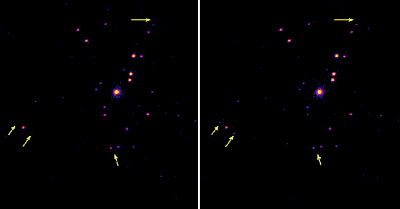|
|
Normal Stars
Similar explosive conditions can also be found in young stars. They have
turbulent interiors because nuclear reactions have only recently begun and the
star has yet to settle down to accommodate the flow of energy from the interior.
They also rotate rapidly--over the years they will slow down due to the
outflow of gas from their surface. Chandra X-ray images of clusters of young
(meaning less than a few million years old!) stars such as the Orion and rho
Ophiuchi star clusters show that young stars have hot, violently active coronas.
These young stars produce a thousand times more X-rays than the Sun.

Chandra's remarkable X-ray view of the Orion Nebula, one of the
closest star-forming regions to Earth.
|
This raises an intriguing question. Did the Sun produce a thousand times more
X-rays when it was young? If so, how did this affect the evolution and chemistry
of the atmosphere of the
Earth? X-ray observations of young stars should give us insight into the
conditions under which life formed on Earth.
Feel like a star expert? Try our Star Search word search!
|